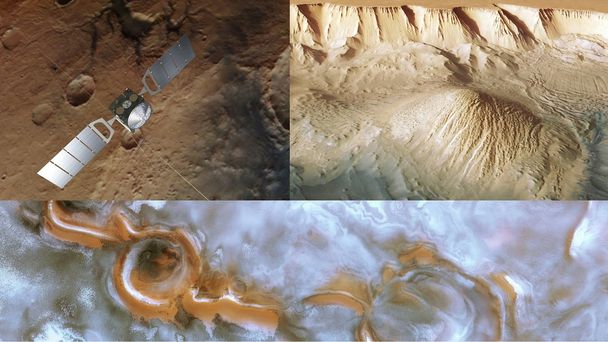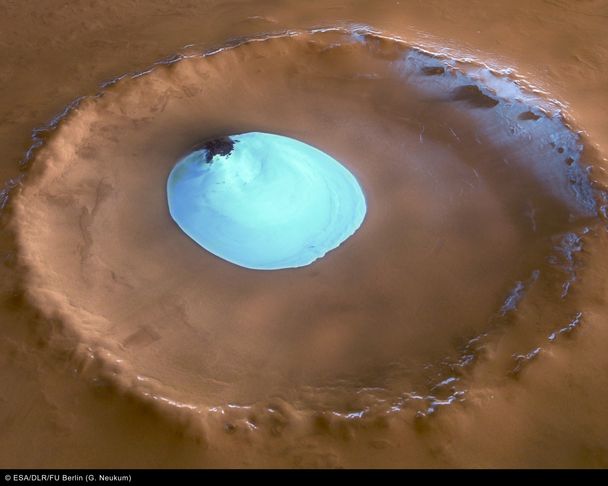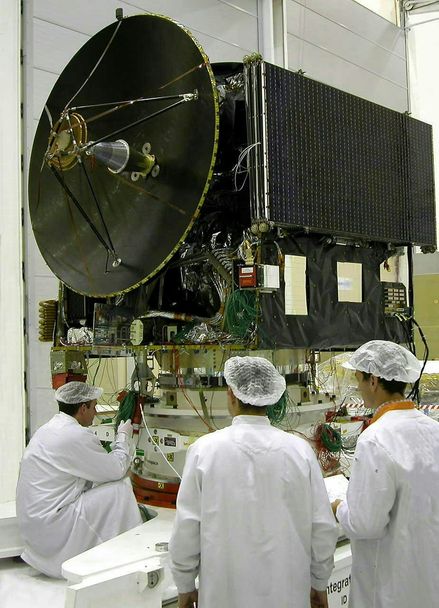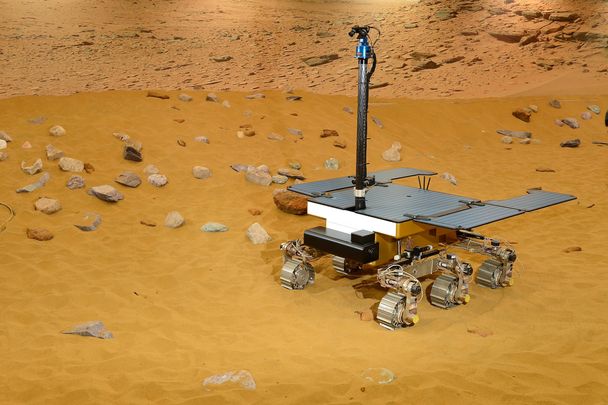20 years in space, the exceptional odyssey of Mars Express

Ever since Galileo first observed Mars through a telescope in 1610, scientists have been increasingly drawn to the planet. More than fifty exploration missions, including Mars Express, have enabled us to learn more about the planet and prepare for future missions.
The geological and climatic similarities with Earth have made Mars the focus of some of the most ambitious exploration programmes in the solar system. One of these is Mars Express, which today celebrates its 20th anniversary since launch. This incredible mission, for which Airbus was the prime contractor, not only collected essential data but also prepared the way for subsequent missions.
An active orbiter for 20 years
Mars Express was the European Space Agency's (ESA) first planetary mission when it was launched on 2 June 2003, comprising an orbiter carrying a suite of scientific instruments, including a lander called Beagle 2. While the latter did not function properly once it reached the surface of Mars, the orbiter and its instruments were a resounding success.
Initially designed for a mission duration of one Martian year (or 687 Earth days), the orbiter is one of the oldest spacecraft in operation beyond Earth and its mission has been extended several times. The technology designed 20 years ago is still standing up to the hostile environment of interplanetary space.
The instruments on board have provided fundamental information on the topology and composition of the planet's surface, subsurface and atmosphere. The initial objective was to create detailed maps of the planet and, in particular, to search for signs of underground water.

This HRSC image provides a perspective view of residual water ice on the floor of Vastitas Borealis Crater on Mars. © ESA/DLR/FU Berlin
Mission accomplished!
The satellite has provided breathtaking three-dimensional views of Mars, as well as the most complete map of the chemical composition of the atmosphere. It has found water ice in the Martian polar caps and water buried beneath them, as well as rocks showing the former presence of oceans and lakes. Mars Express has enabled us to better understand how most of the Martian atmosphere has been stripped away over time. These scientific discoveries have completely transformed our vision of the planet.
In addition, Mars Express plays an essential role in relaying communications between landers on the Martian surface and Earth. It has been used to relay data from almost all the other missions that have successfully landed on Mars, including Perseverance, making it one of the most important tools for exploring the Solar System.

This image, taken by the High Resolution Stereo Camera (HRSC) on board ESA’s Mars Express spacecraft, shows a section of the Ophir Chasma, a northern part of the Valles Marineris canyon. © ESA/DLR/FU Berlin
Fundamental technological skills for following missions
Frédéric Faye, Chief Engineer for Mars Express, says: "We used the same technologies as those used for the European comet-chaser Rosetta, as well as the European instruments previously created for Mars 96, to develop Mars Express. Its technological building blocks were then used for other missions, including Venus Express."

Mars Express being tested in our cleanroom in Toulouse.
The characteristics of the Mars Express mission did not allow it to carry much fuel. "To compensate for this, we worked with ESA's mission analysis groups to design a mission that would operate in an elliptical orbit, with the satellite flying at an altitude of between 250 and 10,000 km, enabling both high-resolution observations and a more global view. However, we gave ourselves some flexibility in the final choice of orbit by creating a satellite compatible with aerobraking techniques, i.e. using the atmosphere to slow the satellite down." This technique allows the satellite's orbit to be modified without changing anything, and was later successfully used on Venus Express.
"The Mars Express mission required strong manoeuvrability with a fairly powerful engine, firstly for insertion around Mars and then for comparatively rapid acquisition of the working orbit. To achieve this, it was necessary to develop configurations with the panels deployed that could withstand the high thrusts adapted to this engine. This knowledge was used with JUICE [editor's note: mission to Jupiter] to define the orientation of the panels, so we knew directly what the right positions were. With Mars Express, we gained technical building blocks and ways of doing things that can be adapted to other satellites.”
Finally,a real problem of autonomy was faced with Mars Express due to the delay between sending a command from Earth to the satellite and its response. "During this lapse of time, which can be as long as 40 minutes each way, the satellite may have changed configuration, so we had to implement a strategy for autonomous satellite operations that would allow it to disregard a bad command from the ground due to a change in onboard conditions. The delay is exacerbated on a mission like JUICE, with a delay of more than 90 minutes. The experience on Mars Express enabled us to anticipate this behaviour and better understand the level of autonomy that needed to be built into the satellite.”
Studying Mars to understand the Earth and its evolution
The data from Mars Express enables scientists to carry out comparative planetology. For example, Mars initially had oceans and an atmosphere, and understanding their disappearance provides clues about the future evolution of the Earth.
As Frédéric explains: "If we compare it with Venus, we can see that the change in its atmosphere seems to be the result of a runaway climate, with temperatures now reaching an unbearable 400°C. This raises questions about the climate change we are seeing on Earth today."
Understanding the history of the planets, the evolution of their climate and their atmosphere will enable us to calculate terrestrial climate models and develop new ones. With the answers we will learn more about the origin of the Earth and be able to model its evolution.

This sweeping view along a rusty red ridge and into a crater showcases the exquisite beauty of icy, layered terrain in the south polar region on Mars. © ESA/DLR/FU Berlin
Preparing for the next Mars missions: ExoMars and ERO
Mars today is home to more spacecraft, orbiters, landers and rovers than any planet outside Earth. The increasing amount and precision of data on the surface and Mars is making it possible to identify landing zones and help in the decision-making process for future spacecraft bound for the planet.
"Mars Express, as a rendezvous mission i.e. orbiting the planet, has made it possible to look at the most interesting areas for landers. The data on the surface will also be used for future rover missions," says Frédéric.
Airbus continues to play a major role in future missions to Mars with ExoMars and Earth Return Orbiter (ERO).
Built by Airbus Defence and Space, the ExoMars rover - named Rosalind Franklin - is Europe's first rover mission to the Red Planet. Scheduled for launch in 2028, its aim is to search for evidence of past or present life on Mars - equipped with a drill capable of going 2 metres below the surface - and to help better understand the history of water on the planet.

Testing the ExoMars rover in our Mars yard in Stevenage © Airbus
The other exceptional mission for Airbus will be the Earth Return Orbiter (ERO) as part of the Mars Sample Return campaign, which will collect samples in Martian orbit and be the very first spacecraft to return samples to Earth.
For more information: https://www.airbus.com/en/products-services/space/exploration/mars